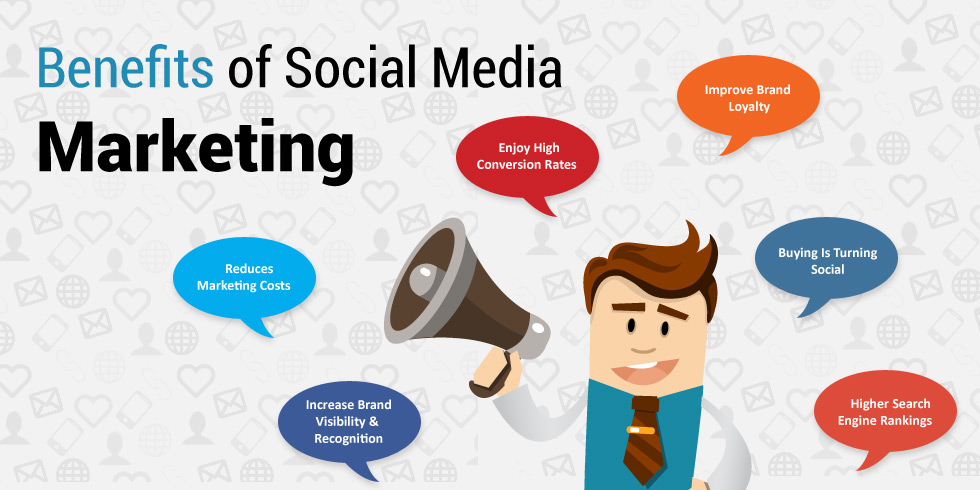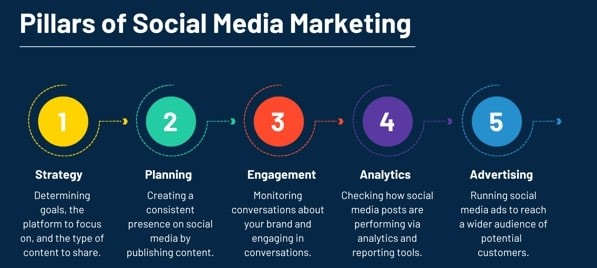
Introduction
Social media marketing refers to promoting products, services, or brands through social media platforms like Facebook, Instagram, Twitter, LinkedIn, and others. It involves creating and sharing content on these platforms, engaging with your target audience, and analyzing and measuring the results of your efforts. In addition, social media marketing is a cost-effective way to reach a large and diverse audience, build relationships with customers, and stay ahead of the competition in today’s digital age.
Incredible Benefits of Social Media Marketing

It has developed into a crucial component of many companies’ marketing plans. Some of the main advantages of social media marketing are listed below:
1. Increased brand awareness
Additionally, businesses can contact a broad population and raise brand recognition using social media platforms.
2. Improved customer engagement
Social media provides businesses with a direct line of communication with their customers, which can lead to improved engagement and customer loyalty.
3. Cost-effective
Compared to traditional marketing methods, social media marketing is often more affordable, making it accessible to businesses of all sizes.
4. Increased website traffic
social media can boost website traffic, which could result in more customers and transactions.
5. Targeted advertising
Additionally, by leveraging social media platforms, businesses can precisely target specific audiences based on their demographics, interests, and behaviors, leading to a more successful advertising campaign.
6. Real-time feedback
Social media provides businesses with real-time feedback from their customers, which can help them improve their products and services.
7. Competitive advantage
By establishing a strong social media presence, businesses can gain a competitive advantage over their competitors who may not be using social media effectively.
Pillars of Social Media Marketing Success

There are several key pillars of the social media marketing that businesses can use to develop effective marketing strategies. These include:
1. Content Strategy
Developing a content strategy involves creating and sharing high-quality content that is relevant to your target audience. This can include blog posts, videos, images, and other types of content that engage your audience and encourage them to share your content with others.
2. Audience Targeting
Social media platforms offer businesses a range of targeting options to reach their desired audience. In addition, demographics, hobbies, habits, and other factors may be included.
3. Engagement
Engaging with your audience is an important part of this marketing. Moreover, this includes responding to comments and messages, sharing user-generated content, and actively participating in conversations related to your brand.
4. Analytics
Understanding what is effective and what requires improvement from your marketing campaigns depends on measuring their success. Social media analytics can help you track metrics such as engagement, reach, and conversions.
5. Advertising
Moreover, social media advertising allows businesses to target specific audiences with their content and reach a larger audience. Advertising can include paid social media campaigns, influencer marketing, and other forms of promotion.
How to Implement

Implementing social media marketing requires a strategic approach. Here are some starting points:
1. Set Goals
Start by defining your marketing goals. You should determine what you want to achieve with your marketing efforts, whether it’s building brand awareness, increasing website traffic, or driving sales.
2. Choose Platforms
Identify the social media platforms that are most relevant to your target audience. Moreover, Facebook, Instagram, Twitter, LinkedIn, and YouTube are among the most widely used platforms for social media marketing.
3. Develop a Content Strategy
In addition, create a content strategy that aligns with your marketing goals. This should include the types of content you will create, how often you will post, and the tone and style of your messaging.
4. Build Your Audience
Targeted advertising and engagement tactics can help build your social media following. Respond to their comments and messages, and share user-generated material to interact with your community.
5. Track Metrics
Use social media analytics tools to track your metrics, including engagement rates, click-through rates, and conversion rates. Certainly, use this information to continuously improve your plan.
6. Experiment and Adapt
Social media is constantly evolving, it’s important to experiment with different types of content and tactics to see what works best for your brand. Furthermore, be willing to adapt and adjust your strategy based on what you learn.
Summary
- It is an effective instrument for companies to contact their target market, increase brand recognition, and boost sales.
- Key pillars of this marketing include content strategy, audience targeting, engagement, analytics, and advertising.
- Moreover, social media platforms enable businesses to target specific audiences based on demographics, interests, and behaviors, resulting in more effective advertising campaigns.
- In addition, engagement is a critical component of social media marketing, as it indicates that followers are interacting with the content being shared. Higher engagement rates can lead to increased brand awareness, improved customer loyalty, and higher conversion rates.
FAQ
Q.1 How much does social media marketing cost?
The cost of social media marketing varies depending on the platform used, the scope of the campaign, and the expertise of the marketing team. Additionally, businesses should expect to spend a few thousand dollars per month for a basic social media marketing campaign.
Q.2 Will social media marketing effects be visible?
The time it takes to see results from social media marketing can vary depending on the goals of the campaign, the target audience, and the amount of effort put into the campaign. Moreover, businesses should expect to see some results within a few weeks to a few months of starting a campaign.
Q.3 How often should I post on social media?
The frequency of social media posts will depend on the platform used and the audience being targeted. Furthermore, posting at least once per day on platforms like Facebook and Instagram, and several times per day on platforms like Twitter, is recommended for businesses.
Q.4 How important is engagement on social media?
Furthermore, engagement is a critical component of social media marketing, as it indicates that followers are interacting with the content being shared. Higher engagement rates can lead to increased brand awareness, improved customer loyalty, and higher conversion rates.


